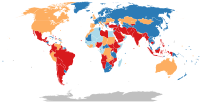
Photo from wikipedia
In the context of the 2020 world pandemic of COVID-19, many professional and scientific associations have had to change the way that they gather and reorganize their scholarly conferences. For… Click to show full abstract
In the context of the 2020 world pandemic of COVID-19, many professional and scientific associations have had to change the way that they gather and reorganize their scholarly conferences. For many of them, conferences are a main source of income and important occasions for business meetings and managerial decisions. Yet, with trips and face-to-face encounters banned, the opportunity arrived for going virtual and developing human and technical capacities to provide online environments for virtual conferences. In this article, we analyze the case of an e-conference co-organized by two international organizations at two levels: (a) the decision-making process and (b) the assessment by attendees. Relying on personal, first-hand experience, participant observation, and a post-conference survey, we collected data that allow an examination of the intricacies of the decision to go virtual as well as pros and cons of the experiences of colleagues who presented papers and attended sessions. Consistent with previous studies, we found that scholars value the possibility of having more colleagues participating (providing geographic and career stage diversity), reduction of carbon emissions, lower travel and transportation costs, and ease of watching presentations later (through recordings). On the other hand, academics point to the difficulty of socializing as the main problem, with implications for strengthening academic networks and consolidation of professional careers.
Journal Title: First Monday
Year Published: 2022
Link to full text (if available)
Share on Social Media: Sign Up to like & get
recommendations!